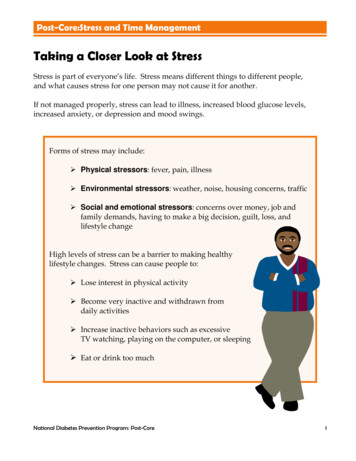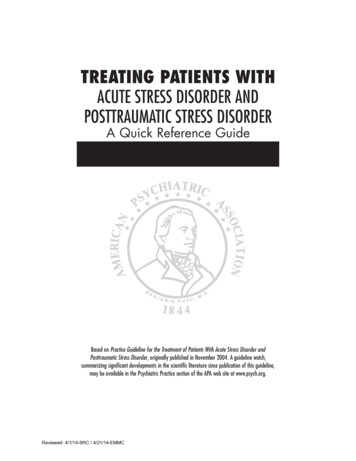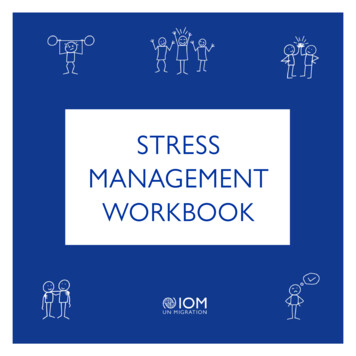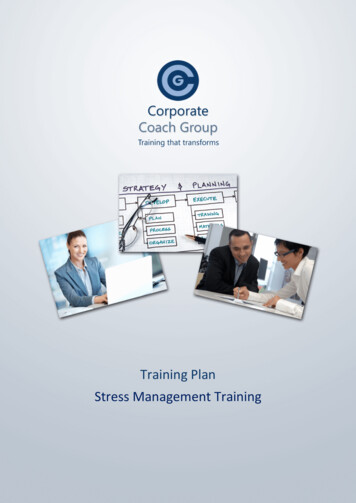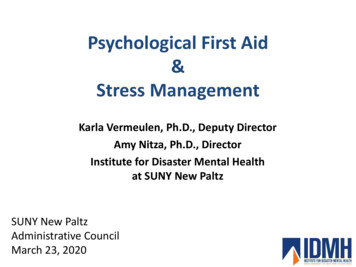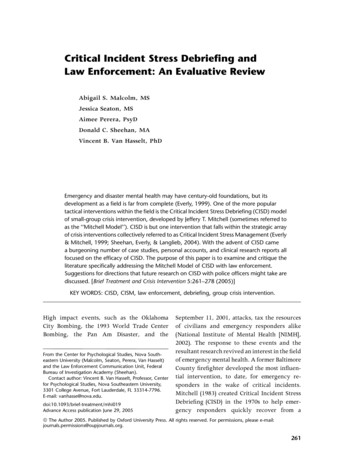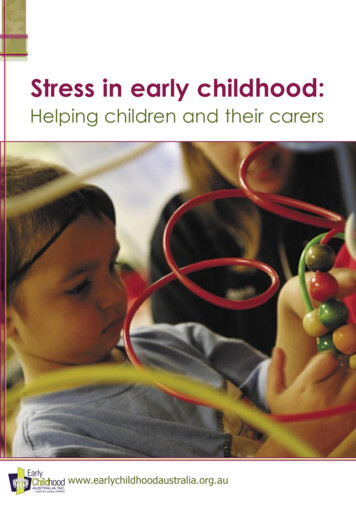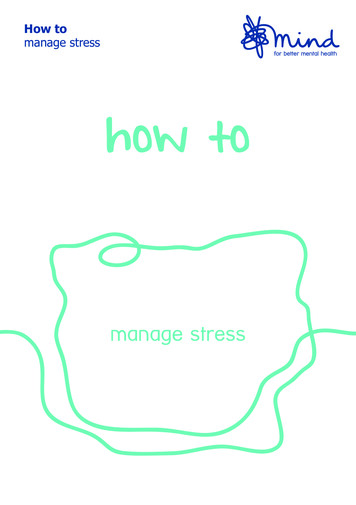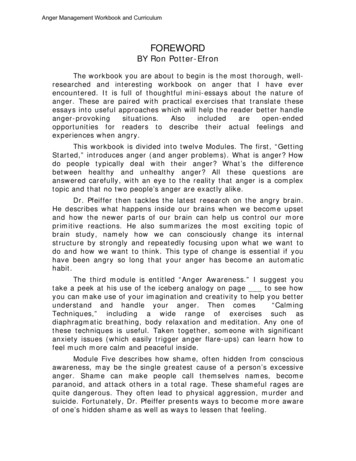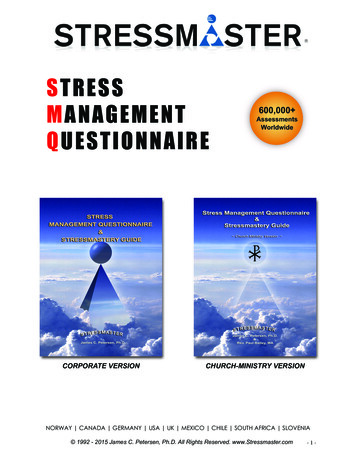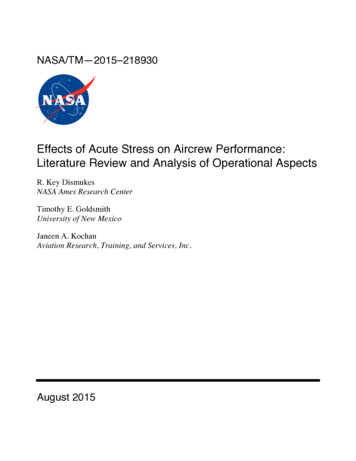
Transcription
NASA/TM—2015–218930Effects of Acute Stress on Aircrew Performance:Literature Review and Analysis of Operational AspectsR. Key DismukesNASA Ames Research CenterTimothy E. GoldsmithUniversity of New MexicoJaneen A. KochanAviation Research, Training, and Services, Inc.August 2015
NASA STI Program in ProfileSince its founding, NASA has been dedicatedto the advancement of aeronautics and spacescience. The NASA scientific and technicalinformation (STI) program plays a key part inhelping NASA maintain this important role. CONFERENCE PUBLICATION.Collected papers from scientific andtechnical conferences, symposia,seminars, or other meetings sponsoredor co-sponsored by NASA.The NASA STI program operates under theauspices of the Agency Chief InformationOfficer. It collects, organizes, provides forarchiving, and disseminates NASA’s STI. TheNASA STI program provides access to theNTRS Registered and its public interface, theNASA Technical Reports Server, thus providingone of the largest collections of aeronautical andspace science STI in the world. Results arepublished in both non-NASA channels and byNASA in the NASA STI Report Series, whichincludes the following report types: SPECIAL PUBLICATION. Scientific,technical, or historical informationfrom NASA programs, projects, andmissions, often concerned withsubjects having substantial publicinterest. TECHNICAL TRANSLATION.English-language translations offoreign scientific and technicalmaterial pertinent to NASA’s mission.Specialized services also include creatingcustom thesauri, building customizeddatabases, and organizing and publishingresearch results. TECHNICAL PUBLICATION. Reports ofcompleted research or a major significantphase of research that present the results ofNASA programs and include extensivedata or theoretical analysis. Includescompilations of significant scientific andtechnical data and information deemed tobe of continuing reference value. NASAcounterpart of peer-reviewed formalprofessional papers but has less stringentlimitations on manuscript length and extentof graphic presentations.For more information about the NASA STIProgram, see the following: Access the NASA STI Program homepage at http://www.sti.nasa.gov E-mail your question via the Internet tohelp@sti.nasa.gov Fax your question to the NASA STIHelp Desk at (757) 864-6500 TECHNICAL MEMORANDUM.Scientific and technical findings that arepreliminary or of specialized interest, e.g.,quick release reports, working papers, andbibliographies that contain minimalannotation. Does not contain extensiveanalysis. Phone the NASA STI Help Desk at(757) 864-9658 Write to:NASA STI ProgramSTI Support ServicesMail Stop 148NASA Langley Research CenterHampton, VA 23681-2199 CONTRACTOR REPORT. Scientific andtechnical findings by NASA-sponsoredcontractors and grantees.ii
NASA/TM—2015–218930Effects of Acute Stress on Aircrew Performance:Literature Review and Analysis of Operational AspectsR. Key DismukesNASA Ames Research CenterTimothy E. GoldsmithUniversity of New MexicoJaneen A. KochanAviation Research, Training, and Services, Inc.National Aeronautics andSpace AdministrationAmes Research CenterMoffett Field, California 94035-1000August 2015iii
Available from:NASA STI ProgramSTI Support ServicesMail Stop 148NASA Langley Research CenterHampton, VA 23681-2199This report is also available in electronic form at http://www.sti.nasa.goviv
Table of Contents1. What is Stress? .2. Flightcrew Errors in Airline Accidents .3. Attention and Working Memory .4. Decision-Making .5. Team Performance and Communication .6. Ways to Reduce Error Vulnerability .7. Directions for Future Research .8. Implications for NextGen .References.233455677Appendix A. Selective Review of Stress Literature: Implications for Pilot Performance. A-101. Stress: An Overview . A-202. Attention and Stress . A-62.1 Implications for Pilot Performance in Non-Normal Situations . A-903. Startle and Surprise . A-1104. Memory. A-114.1 Working Memory . A-114.2 Stress Effects on Memory . A-124.3 Implications for Cockpit Non-Normal Situations. A-1405. Skilled Performance. A-1406. Human Decision Making under Stress . A-156.1 What is Decision Making?. A-166.2 Laboratory Tasks Used to Study Human Decision Making . A-176.3 Stress and Human Decision Making. A-176.4 General Effects of Stress on Deciding . A-186.5 Rational-Analytic Decision Making . A-186.6 Naturalistic Decision Making . A-186.7 Judgemental Heuristics . A-1907. Decison Making, Team Performance, and Stress . A-227.1 The Nature of Team Decision Making . A-227.2 The Effects of Stress on Team Decision Making . A-237.3 Ways of Decreasing the Stress Effects on Team Performance . A-247.4 Summary of Decision Making and Stress . A-2608. Naturalistic Studies . A-2709. Stress Management Training . A-2810. Summary and Conclusions . A-29References. A-31Appendix B. Stress and Flightcrew Performance: Types of Errors Occuring in Airline AccidentsExecutive Summary .1. Overview.2. Method .vB-1B-2B-4B-5
2.1 Subject Matter Experts. B-52.2 Selection of Accidents . B-62.3 Analysis . B-82.3.1 Identification of Flightcrew Errors . B-82.3.2 Categorization of the Errors: Error Types and Error Categories . B-103. Results and Discussion . B-143.1 Error Types and Categories . B-143.1.1 Error Category 1: Inadequate Comprehension/Interpretation/Assessment . B-143.1.2 Error Category 2: Poor Management of Competing Task Demands . B-163.1.3 Error Category 3: Inadvertent Omission of Required Actions . B-183.1.4 Error Category 4: Inadequate or Improper Communication . B-213.1.5 Error Category 5: Inadequate/Improper Execution of Tasks . B-223.1.6 Error Category 6: Poor Decision-Making or Choice of Actions . B-233.1.7 Error Category 7: Inadequate Physical Execution of Action . B-243.1.8 Error Category 8: Fail to Acquire Information . B-253.1.9 Summary of Error Categories . B-253.2 Which Pilot Made the Error? . B-263.3 Other Aspects. B-264. Conclusions. B-27References. B-28Synopses of Accidents . B-36Table B1. The Twelve Accidents Analyzed in the Current Study. B-7Table B2. Number of Errors by Crew Position/Function . B-9Table B3. Number of Errors by Phase of Flight . B-9Table B4. Number of Inadvertent and Deliberate Errors. B-10Table B5. Number of Errors of Omission and Errors of Commission . B-10Table B6. The 49 Error Types and their Frequency across the 212 Errors . B-11Table B7. The Eight Error Categories and their Corresponding Error Types . B-13Table B8. Checklist Errors Frequencies for Normal and Non-Normal Checklists . B-20Table B9. The Set of 212 Error Statements Generated from the 12 Accidents . B-30Appendix C. Stress and Pilot Performance: Operational Considerations . C-11. Introduction and Overview of Stress Effects . C-21.1 Stress Defined . C-21.2 Attention and Working Memory . C-31.3 Decision-Making . C-41.4 Team Performance and Communication . C-51.5 Accident Errors . C-52. Ways to Reduce Error Vulnerability . C-72.1 Checklist Design and Content . C-82.2 Training to Mitigate Stress Effects . C-83. Directions for Future Research . C-93.1 Design of Cockpit Interfaces . C-103.2 Design of Procedures and Checklists. C-10vi
3.3 Pilot Training and Stress Management . C-103.4 Individual Differences and Stress . C-113.5 Role of Context (Setting and Circumstances) . C-113.6 Role of Uncertainty and/or Novelty. C-123.7 Mental Perspective. C-123.8 Judgment Heuristics. C-133.9 Individual vs Team (Crew) Effects. C-133.10 Implications for NextGen . C-14References. C-16Table C1. The Eight Error Categories and their Corresponding Error Types . C-6Table C2. Example Syllabus for Stress Mitigation Training . C-17vii
viii
Effects of Acute Stress on Aircrew Performance:Literature Review and Analysis of Operational AspectsR. Key Dismukes1, Timothy E. Goldsmith2, and Janeen A. Kochan3Situational stress can adversely affect the cognition and skilled performance of pilots,as well as experts in other domains. Emergencies and other threatening situationsrequire pilots to execute infrequently practiced procedures correctly and to use theirskills and judgment to select an appropriate course of action, often under highworkload, time pressure, and ambiguous indications, all of which can be stressful.Our current study, consisted of three parts, starting with a critical review of theresearch literature on the effects of stress on skilled performance, going back toWorld War II and continuing to recent and more sophisticated studies of the cognitiveeffects of anxiety. In the second part we analyzed the specific ways stress may haveimpaired the performance of airline crews in twelve major accidents, selected fordiversity of the situations the crews encountered. The third part examined theoperational significance and practical implications of the findings from the first twoparts, suggested specific ways to reduce the harmful effects of stress on flight crews,and identified aspects requiring further research. Even though this study focused onflight crews, the findings apply to the effects of stress on the skilled performance ofexperts in almost any domain.In September 2014 we completed the last of a series of three reports on the effects of stress on pilotperformance, which were sponsored by the FAA Division of Human Factors4. These reportsexamined the effects of acute situational threats, rather than chronic life stress, on pilot cognitionand behavior. (For a review of the effects of chronic life stress, see Young, 2008.) Emergencies andother threatening situations require pilots to execute infrequently practiced procedures correctly andto use their skills and judgment to select an appropriate course of action, often under high workload,time pressure, and ambiguous indications.The performance of even the most skilled experts can be impaired by situational stress. The researchliterature on the effects of stress goes back to World War II. Our first report reviewed the existingresearch literature, and the second reported our own study of the specific ways stress may haveimpaired the performance of airline crews in twelve major accidents. The third report examined theoperational significance and practical implications of the first two reports, suggested specific waysto reduce the harmful effects of stress on flight crews, and identified aspects requiring furtherresearch.1NASA Ames Research Center.University of New Mexico.3Aviation Research, Training, and Services, Inc.4FAA Grant 12-G-009 to the University of New Mexico.21
These three reports are collected in this NASA TM to provide ready access to both the humanfactors community and the aviation operational community. This overview summarizes our principlefindings and highlights critical issues.5 One might note that although we focus on flight crewperformance, the issues and findings we report apply equally to the skilled performance of almost allexperts, from surgical teams to firefighters.1. What is Stress?In everyday parlance the word stress is used in loose and varied ways to refer to almost any difficultsituation humans encounter. Sometimes stress refers to a cause (the difficult situation) and othertimes to an effect (physiological and/or psychological responses). In this paper, we use the wordstress to refer to effects and the term stressful situations to refer to causes.The physiological literature provides a well-defined picture of two neural/hormonal systems thatrespond to threat with characteristic changes that prepare the body for ‘fight or flight,’ e.g.,increased heart rate and hard breathing. The psychological literature, which is the focus of our study,is more murky. Diverse manipulations have been used in laboratory studies to induce ‘stress,’ forexample, high workload, noise, temperature extremes, electric shock, and social threat. It is not clearthat all of these manipulations work through the same psychological mechanisms, and processesother than stress may also be involved.In most laboratory studies the effects of these manipulations were assessed with simple performancemeasures and the skilled performance of experts was not examined. Some more naturalistic studieshave examined skilled performance but under less controlled conditions. Few studies have examinedthe skilled performance of expert pilots under well-controlled conditions. Consequently, caution isrequired in considering the implications of the research literature for skilled performance. Ourreports focus on cognitive effects for which the research evidence seems strongest, and wetentatively connect this literature with what we know of the cognitive processes underlying theskilled performance of pilots, especially in threatening situations.For the purposes of this study we used a focused and explicit concept of stress based on what isknown as the cognitive appraisal model, for which there is considerable research support (Lazarusand Folkman, 1984). This model proposes that when individuals encounter challenging situationsthey orient both their cognitive and physiological resources to deal with the situation. Physiologicalresponses, such as increased heart rate and force, faster breathing, and restriction of peripheral bloodflow, prepare the body for ‘fight or flight.’ Cognitively, the individual focuses attention to thechallenging situation, mentally preparing for whatever tasks may be required. Up to this point, theindividual’s resources are mobilized to deal with the challenge, but we choose not to call thisstressful because the individual can manage the situation effectively and performance may actuallyimprove. However, if the situation becomes threatening—physically or socially—and the individualis uncertain of his or her ability to manage the threat, anxiety arises. This anxiety is maladaptive,because it disrupts the individual’s ability to manage the threatening situation, particularly bydegrading attention and working memory, both of which are crucial for managing challengingsituations effectively (Eysenck, Derakshan, Santos, and Calvo, 2007).5Extensive literature citations are provided in our first report and, with a few exceptions, are notrepeated in this overview.2
2. Flightcrew Errors in Airline AccidentsIn our second report (Appendix B) we identified 212 errors in 12 airline accidents chosen torepresent a wide cross-section of aircraft types and situations. Readers should note that our studydesign did not allow us to differentiate effects of stress from high workload, time pressure,uncertainty, and unpracticed aspects of the accident situation. But to a large degree that does notmatter for the purposes of this study. Flight crews experience some combination of all these factorsin emergencies, and our goal is to find ways to reduce vulnerability to error in these highly difficultsituations. We do not argue that stress necessarily directly caused the accident pilots’ errors, but thatthe stressful conditions made these errors more likely to occur.In the following sections we summarize findings from our review of the literature on the cognitiveeffects of stress and from our own study of accidents.3. Attention and Working MemoryWe all have an intuitive understanding of what attention is: the focus of one’s mind on one task orthought or stream of sensory input from a myriad of other possibilities. Basically, we can only fullyattend to one stream of information at a given moment. If we must deal with multiple tasks, we areforced to switch attention back and forth among them, somewhat like a spotlight.Working memory is a very small subset of the vast store of an individual’s long-term memory,momentarily activated so that it can be quickly accessed and manipulated. A classic example islooking up a telephone number and holding it in mind long enough to dial the number. Workingmemory consists of two components: the information stored and the control processes used tomanipulate the information. For example, adding several numbers in one’s head requires bothstoring information temporarily and manipulating that information. These control processes, knownas executive processes, are also involved in directing attention.The substantial literature on the effects of anxiety on attention and working memory is consistentwith the attention control theory of Eysenck, Derakshan, Santos, and Calvo (2007). Attention isknown to be controlled by two different brain systems: a top-down system that directs attention tosupport the individual’s currently active goals, and a bottom-up system that draws attention toenvironmental stimuli, especially stimuli that are salient, abrupt, or threatening. Attention controltheory posits that anxiety disrupts the balance between the two attentional systems, giving thebottom-up system more weight. Consequently, attention is less under the control of task goals, and ismore easily pulled away by salient or threatening stimuli. Thus, the individual is more easilydistracted from task goals. However, if the threatening stimuli are central to the task’s goals, focusmight actually be improved.Individuals under stress are less able to manage their attention effectively. They are more likely tobe distracted from a crucial task by highly salient stimuli, such as an alarm, or by threatening aspectsof a situation. They may process information less fully and may have difficulty switching attentionamong multiple tasks in a controlled fashion, and consequently their management of the overallsituation may become disjointed and chaotic.Because anxious thoughts tend to preempt working memory’s limited storage capacity, theindividual may have difficulty performing computations that would normally be easy and havedifficulty making sense of the overall situation and updating the mental model of the situation (i.e.,3
situation awareness). In our study of accidents, by far the most common category of errors (50 out of212) involved inadequate comprehension, interpretation, or assessment of the ongoing situation.To understand how stress affects the skilled performance of pilots, especially in emergencies (whichby their nature involve novelty, uncertainty, and threat), one must understand the distinction betweenautomated performance of highly practiced tasks and effortful performance of less familiar tasks thatdraws heavily on attention and working memory. If the threat produces anxiety, pilots’ performanceis likely to be undermined in specific ways. Attention and working memory are essential for tasksinvolving novelty, complexity, or danger. Performing tasks requiring these two limited cognitiveresources is typically slow and effortful. If all tasks depended primarily on these limited resourceswe could hardly function in the world. Fortunately, with highly practiced tasks, our dependence onthese two limited resources diminishes considerably, performance becomes largely automatic, andwe can perform these practiced tasks with minimum attention and effort, as, for example, whendriving a car.Highly practiced skills, such as manual operation of flight controls, are less vulnerable to stressbecause they are largely automated and are less dependent on attention and working memory.Inadequate execution of a physical action occurred only ten times among the 212 errors ( 5%)identified in our accident study. However, emergencies almost always require interweaving highlypracticed tasks with less familiar tasks, novel situational aspects, and uncertainty. Thus, in anemergency situation, overall demands on attention and working memory are very high at a timewhen these limited cognitive resources may be disrupted by anxiety; consequently, tasks such asdecision-making, team performance, and communication that depend heavily on attention andworking memory are likely to be impaired4. Decision-MakingResearch has shown decision-making under stress to become less systematic and more hurried, andthat fewer alternative choices are considered when making decisions. However, in highly practicedsituations experts make decisions largely by automatic recognition of the situation and retrieval ofthe appropriate response from long-term memory of previous experiences. This is why pilots arerequired to practice responding to some emergency situations. Thus, experts such as pilots areprotected from impairment from stress under very familiar situations, at least to some extent. Forexample, airline pilots are often given an engine failure during recurrent simulator training, and sopilots are typically fairly reliable in executing the appropriate response when experiencing an actualengine failure emergency in flight, even though the situation is somewhat stressful.Unfortunately, most emergency situations are not rehearsed. Even in cases where the emergencyprocedures are practiced, the decisions that the pilot needs to make to respond appropriately in aparticular emergency may be unique, and thus the required decision-making is not rehearsed. Forexample, the immediate responses to an engine fire in flight are practiced in recurrent training andare likely to be fairly reliable. But, the decisions about the next steps to take depend on where theaircraft is, fuel remaining, weather, and many other variables. Consequently, deliberate thought isrequired about these aspects, and such necessary deliberation may be impaired by the stress that isinduced during the emergency.The decisions made by pilots involved in accidents are often criticized. Indeed it is easy to identify,after the fact, what the pilots could have done to avert the accidents. But, as we have previously4
argued (Dismukes, Berman, and Loukopoulos, 2007), that kind of assessment suffers from hindsightbias. In our current study of accident errors, we found relatively few examples of poor decisionmaking or poor choice of action (16 of 212 errors). We suspect that—at least in the case ofexperienced airline pilots—’poor decision-making’ may be used as a catch-all category, and wesuggest investigations would be better served by deeper analysis of underlying cognitive factors.5. Team Performance and CommunicationIn many studies, researchers have found that under acute stress team members search for and shareless information, tend to neglect social and interpersonal cues, and often confuse their roles andresponsibilities. Stress hinders team perf
NASA/TM—2015–218930 Effects of Acute Stress on Aircrew Performance: Literature Review and Analysis of Operational Aspects R. Key Dismukes NASA Ames Research Center Timothy E. Goldsmith University of New Mexico Janeen A. Kochan Aviation Research, Training, and Services, Inc. National
